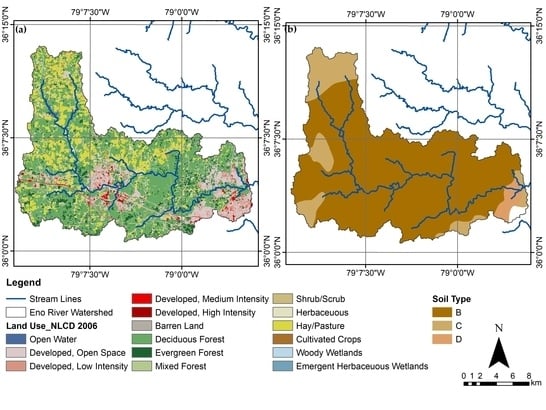Using Geospatial Analysis and Hydrologic Modeling to Estimate Climate Change Impacts on Nitrogen Export: Case Study for a Forest and Pasture Dominated Watershed in North Carolina
Abstract
1. Introduction
2. Materials and Methods
2.1. Study Area
2.2. Data Preparation
2.3. Soil and Water Assessment Tool (SWAT) Model Setup
2.4. Downscaled Future Climate Data
3. Results
3.1. Model Calibration and Validation
3.2. Projected Changes in Streamflow
3.3. Projected Changes in Nitrogen Transport
4. Discussion
5. Conclusions
Author Contributions
Funding
Acknowledgments
Conflicts of Interest
References
- Cubasch, U.; Meehl, G.A.; Boer, G.J.; Stouffer, R.J.; Dix, M.; Noda, A.; Senior, C.A.; Raper, S.; Yap, K.S. The scientific basis. In Contribution of Working Group I to the Third Assessment Report of the Intergovernmental Panel on Climate Change; IPCC: Geneva, Switzerland, 2001. [Google Scholar]
- Suddick, E.; Whitney, P.; Townsend, A.; Davidson, E. The role of nitrogen in climate change and the impacts of nitrogen—Climate interactions in the United States: Foreword to thematic issue. Biogeochemistry 2013, 114, 1–10. [Google Scholar] [CrossRef]
- Lettenmaier, D.P.; Wood, E.F.; Wallis, J.R. Hydro−climatological trends in the continental United−States, 1948−88. J. Clim. 1994, 7, 586–607. [Google Scholar] [CrossRef]
- Pachauri, R.K.; Reisinger, A. Climate Change 2007: Synthesis Report; Contribution of Working Groups I, II and III to the Fourth Assessment Report of the Intergovernmental Panel on Climate Change; The Intergovermental Panel on Climate Change: Geneva, Switzerland, 2007. [Google Scholar]
- Murdoch, P.S.; Baron, J.S.; Miller, T.L. Potential effects of climate change on surface—Water quality in North America. J. Am. Water Resour. Assoc. 2000, 36. [Google Scholar] [CrossRef]
- Vitousek, P.M.; Aber, J.D.; Howarth, R.W.; Likens, G.E.; Matson, P.A.; Schindler, D.W.; Schlesinger, W.H.; Tilman, D.G. Human alteration of the global nitrogen cycle: Sources and consequences. Ecol. Appl. 1997, 7, 737–750. [Google Scholar] [CrossRef]
- Hoagland, P.; Anderson, D.M.; Kaoru, Y.; White, A.W. The economic effects of harmful algal blooms in the United States: Estimates, assessment issues, and information needs. Estuaries 2002, 25, 819–837. [Google Scholar] [CrossRef]
- Heisler, J.; Glibert, P.M.; Burkholder, J.M.; Anderson, D.M.; Cochlan, W.; Dennison, W.C.; Dortch, Q.; Gobler, C.J.; Heil, C.A.; Humphries, E.; et al. Eutrophication and harmful algal blooms: A scientific consensus. Harmful Algae 2008, 8, 3–13. [Google Scholar] [CrossRef] [PubMed]
- US Environmental Protection Agency. National Coastal Condition Report; EPA-620/R-01/005; USEPA Office of Research and Development: Washington, DC, USA, 2001.
- Morris, J.G., Jr. Harmful algal blooms: An emerging public health problem with possible links to human stress on the environment. Annu. Rev. Energy Environ. 1999, 24. [Google Scholar] [CrossRef]
- Girvetz, E.H.; Zganjar, C.; Raber, G.T.; Maurer, E.P.; Kareiva, P.; Lawler, J.J. Applied climate—Change analysis: The climate Wizard tool. PLoS ONE 2009, 4. [Google Scholar] [CrossRef] [PubMed]
- Arnold, J.G.; Srinivasan, R.; Muttiah, R.S.; Williams, J.R. Large area hydrologic modeling and assesment Part I: Model development. JAWRA J. Am. Water Resour. Assoc. 1998, 34, 73–89. [Google Scholar] [CrossRef]
- Winchell, M.; Srinivasan, R.; Di Luzio, M.; Arnold, J.G. ArcSWAT Interface For SWAT2012 User’s Guide; Blackland Research Center, Texas AgriLife Research: College Station, TX, USA, 2013. [Google Scholar]
- Reichler, T.; Kim, J. How well do coupled models simulate today’s climate. Bull. Am. Meteorol. Soc. 2008, 89, 303–311. [Google Scholar] [CrossRef]
- Brekke, L.D.; Dettinger, M.D.; Maurer, E.P.; Anderson, M. Significance of model credibility in estimating climate projection distributions for regional hydroclimatological risk assessments. Clim. Chang. 2008, 89, 371–394. [Google Scholar] [CrossRef]
- Pierce, D.W.; Barnett, T.P.; Santer, B.D.; Gleckler, P.J. Selecting global climate models for regional climate change studies. Proc. Natl. Acad. Sci. USA 2009, 106, 8441–8446. [Google Scholar] [CrossRef] [PubMed]
- Maurer, E.P.; Brekke, L.; Pruitt, T.; Duffy, P.B. Fine—Resolution climate projections enhance regional climate change impact studies. Eos Trans. Am. Geophys. Union 2007, 88. [Google Scholar] [CrossRef]
- Gombault, C.; Madramootoo, C.A.; Michaud, A.; Beaudin, I.; Sottile, M.-F.; Chikhaoui, M.; Ngwa, F. Impacts of climate change on nutrient losses from the Pike River watershed of southern Québec. Can. J. Soil Sci. 2015. [Google Scholar] [CrossRef]
- Marcinkowski, P.; Piniewski, M.; Kardel, I.; Szcześniak, M.; Benestad, R.; Srinivasan, R.; Ignar, S.; Okruszko, T. Effect of climate change on hydrology, sediment and nutrient losses in two lowland catchments in Poland. Water 2017, 9, 156. [Google Scholar] [CrossRef]
- Ye, L.; Grimm, N.B. Modelling potential impacts of climate change on water and nitrate export from a mid−sized, semiarid watershed in the US Southwest. Clim. Chang. 2013, 120, 419–431. [Google Scholar] [CrossRef]
- Ahmadi, M.; Records, R.; Arabi, M. Impact of climate change on diffuse pollutant fluxes at the watershed scale. Hydrol. Process. 2013, 28, 1962–1972. [Google Scholar] [CrossRef]
- Praskievicz, S.; Chang, H. Impacts of climate change and urban development on water resources in the Tualatin River Basin, Oregon. Ann. Assoc. Am. Geogr. 2011, 101, 249–271. [Google Scholar] [CrossRef]
- Psaris, M.; Chang, H. Assessing the impacts of climate change, urbanization, and filter strips on water quality using SWAT. Int. J. Geospatial Environ. Res. 2014, 1, 1. [Google Scholar]
- Gesch, D.; Oimoen, M.; Greenlee, S.; Nelson, C.; Steuck, M.; Tyler, D. The national elevation dataset. Photogramm. Eng. Remote Sens. 2002, 68, 5–11. [Google Scholar]
- Fry, J.; Xian, G.; Jin, S.; Dewitz, J.; Homer, C.; Yang, L.; Barnes, C.; Herold, N.; Wickham, J. Completion of the 2006 national land cover database for the conterminous United States. Photogramm. Eng. Remote Sens. 2006, 77, 858–864. [Google Scholar]
- Larose, M.; Heathman, G.C.; Norton, L.D.; Engel, B. Hydrologic and atrazine simulation of the cedar creek watershed using the SWAT model. J. Environ. Qual. 2007, 36, 521. [Google Scholar] [CrossRef] [PubMed]
- Ercan, M.B.; Goodall, J.L. Estimating watershed—Scale precipitation by combining gauge−and radar−derived observations. J. Hydrol. Eng. 2012, 18, 983–994. [Google Scholar] [CrossRef]
- Runkel, R.L.; Crawford, C.G.; Cohn, T.A. Load Estimator (Loadest): A Fortran Program for Estimating Constituent Loads in Streams and Rivers; U.S. Geological Survey: Reston, VA, USA, 2004.
- Gassman, P.W.; Reyes, M.R.; Green, C.H.; Arnold, J.G. The Soil and Water Assessment Tool: Historical Development, Applications, and Future Research Directions; Center for Agricultural and Rural Development, Iowa State University: Ames, IA, USA, 2007. [Google Scholar]
- U.S. Environmental Protection Agency. Protocol for Developing Pathogen TMDLs First Edition; U.S. Environmental Protection Agency: Washington, DC, USA, 1999.
- Rallison, R.E.; Miller, N. Past, present, and future SCS runoff procedure. In Proceedings of the International Symposium on Rainfall-Runoff Modeling, 18−21 May 1981; Singh, V.P., Ed.; Mississippi State University: Starkville, MS, USA, 1982. [Google Scholar]
- Allen, R.G. A penman for all seasons. J. Irrig. Drain. Eng. 1986, 112, 348–368. [Google Scholar] [CrossRef]
- Williams, J.R. Flood routing with variable travel time or variable storage coefficients. Trans. ASAE 1969, 12, 100–103. [Google Scholar] [CrossRef]
- McElroy, A.D. Loading Functions for Assessment of Water Pollution from Nonpoint Sources; US Environmental Protection Agency, Office of Research and Development, Office of Air, Land, and Water Use: Washington, DC, USA, 1976. [Google Scholar]
- Williams, J.R.; Hann, R.W. Optimal Operation of Large Agricultural Watersheds with Water Quality Restraints; Texas Water Resources Institute: College Station, TX, USA, 1978. [Google Scholar]
- Neitsch, S.L.; Arnold, J.G.; Kiniry, J.R.; Williams, J.R. Soil and Water Assessment Tool User’s Manual Version 2005. Diffus. Pollut. Conf. Dublin 2005, 494. [Google Scholar]
- Meehl, G.A.; Covey, C.; Delworth, T.; Latif, M.; McAvaney, B.; Mitchell, J.F.B.; Stouffer, R.J.; Taylor, K.E. The WCRP CMIP3 multimodel dataset: A new era in climatic change research. Bull. Am. Meteorol. Soc. 2007, 88, 1383–1394. [Google Scholar] [CrossRef]
- Baker, N.C.; Huang, H.P. A comparative study of precipitation and evaporation between CMIP3 and CMIP5 climate model ensembles in semiarid regions. J. Clim. 2014, 27, 3731–3749. [Google Scholar] [CrossRef]
- Sun, Q.; Miao, C.; Duan, Q. Comparative analysis of CMIP3 and CMIP5 global climate models for simulating the daily mean, maximum, and minimum temperatures and daily precipitation over China. J. Geophys. Res. 2015, 120, 4806–4824. [Google Scholar] [CrossRef]
- Flato, G.M.; Boer, G.J. Warming asymmetry in climate change simulations. Geophys. Res. Lett. 2001, 28, 195–198. [Google Scholar] [CrossRef]
- Salas−Mélia, D.; Chauvin, F.; Déqué, M.; Douville, H.; Gueremy, J.; Marquet, P.; Planton, S.; Royer, J.; Tyteca, S. Description and validation of the CNRM-CM3 global coupled model. Clim. Dyn. 2005, 103. [Google Scholar]
- Delworth, T.L.; Broccoli, A.J.; Rosati, A.; Stouffer, R.J.; Balaji, V.; Beesley, J.A.; Cooke, W.F.; Dixon, K.W.; Dunne, J.; Dunne, K.A.; et al. GFDL’s CM2 global coupled climate models. Part I: Formulation and simulation characteristics. J. Clim. 2006, 19, 643–674. [Google Scholar] [CrossRef]
- Marti, O.; Braconnot, P.; Bellier, J.; Benshila, R.; Bony, S.; Brockmann, P.; Cadule, P.; Caubel, A.; Denvil, S.; Dufresne, J.-L.; et al. The New IPSL Climate System Model: IPSL−CM4; Institut Pierre−Simon Laplace (IPSL): Paris, France, 2006. [Google Scholar]
- Hasumi, H.; Emori, S. K-1 Coupled GCM (MIROC) Description. K-1 Technical Report, 1. K-1 Model Developers; Center for Climate System Research. University of Tokyo: Tokyo, Japan, 2004. [Google Scholar]
- Legutke, S.; Voss, R. The Hamburg Atmosphere—Ocean Coupled Circulation Model-ECHO-G; DKRZ Technical Report No. 18; German Climate Computer Center: Hamburg, Germany, 1999. [Google Scholar]
- Jungclaus, J.H.; Keenlyside, N.; Botzet, M.; Haak, H.; Luo, J.J.; Latif, M.; Marotzke, J.; Mikolajewicz, U.; Roeckner, E. Ocean circulation and tropical variability in the coupled model ECHAM5/MPI−OM. J. Clim. 2006, 19, 3952–3972. [Google Scholar] [CrossRef]
- Yukimoto, S.; Noda, A.; Kitoh, A.; Sugi, M.; Kitamura, Y.; Hosaka, M.; Shibata, K.; Maeda, S.; Uchiyama, T. The new meteorological research institute coupled GCM (MRI-CGCM2). Model climate and variability. Pap. Meteorol. Geophys. 2001, 51, 47–88. [Google Scholar] [CrossRef]
- Gates, W.L. The use of general circulation models in the analysis of the ecosystem impacts of climatic change. Clim. Chang. 1985, 7, 267–284. [Google Scholar] [CrossRef]
- Beven, K.; Binley, A. The future of distributed models: Model calibration and uncertainty prediction. Hydrol. Process. 1992, 6, 279–298. [Google Scholar] [CrossRef]
- Abbaspour, K.C. SWAT−CUP 2012: SWAT Calibration and Uncertainty Programs—A User Manual; Eawag Swiss Federal Institute Aquatic Science and Technology: Dubendorf, Switzerland, 2012. [Google Scholar]
- Andersen, J.; Refsgaard, J.C.; Jensen, K.H. Distributed hydrological modelling of the Senegal River Basin−model construction and validation. J. Hydrol. 2001, 247, 200–214. [Google Scholar] [CrossRef]
- Deb, K.; Pratab, S.; Agarwal, S.; Meyarivan, T. A fast and elitist multiobjective genetic algorithm: NGSA−II. IEEE Trans. Evol. Comput. 2002, 6, 182–197. [Google Scholar] [CrossRef]
- Ercan, M.B.; Goodall, J.L. Design and implementation of a general software library for using NSGA−II with SWAT for multi−objective model calibration. Environ. Model. Softw. 2016, 84, 112–120. [Google Scholar] [CrossRef]
- Moriasi, D.N.; Arnold, J.G.; Van Liew, M.W.; Bingner, R.L.; Harmel, R.D.; Veith, T.L. Model evaluation guidelines for systematic quantification of accuracy in watershed simulations. Trans. ASABE 2007, 50, 885–900. [Google Scholar] [CrossRef]
- Alexander, R.B.; Smith, R.A.; Schwarz, G.E.; Boyer, E.W.; Nolan, J.V.; Brakebill, J.W. Differences in phosphorus and nitrogen delivery to the Gulf of Mexico from the Mississippi River Basin. Environ. Sci. Technol. 2008, 42, 822–830. [Google Scholar] [CrossRef] [PubMed]
- Najjar, R.G.; Pyke, C.R.; Adams, M.B.; Breitburg, D.; Hershner, C.; Kemp, M.; Howarth, R.; Mulholland, M.R.; Paolisso, M.; Secor, D.; et al. Potential climate—Change impacts on the Chesapeake Bay. Estuar. Coast. Shelf. Sci. 2010, 86, 1–20. [Google Scholar] [CrossRef]
- Rebich, R.A.; Houston, N.A.; Mize, S.V.; Pearson, D.K.; Ging, P.B.; Evan Hornig, C. Sources and delivery of nutrients to the northwestern gulf of mexico from streams in the south-central United States. JAWRA J. Am. Water Resour. Assoc. 2011, 47, 1061–1086. [Google Scholar] [CrossRef] [PubMed]
- Wise, D.R.; Johnson, H.M. Surface-water nutrient conditions and sources in the United States Pacific Northwest. JAWRA J. Am. Water Resour. Assoc. 2011, 47, 1110–1135. [Google Scholar] [CrossRef] [PubMed]
- Alam, M.J.; Goodall, J.L. Toward disentangling the effect of hydrologic and nitrogen source changes from 1992 to 2001 on incremental nitrogen yield in the contiguous United States. Water Resour. Res. 2012, 48. [Google Scholar] [CrossRef]
- Alam, M.J.; Goodall, J.L.; Bowes, B.D.; Girvetz, E.H. The impact of projected climate change scenarios on nitrogen yield at a regional scale for the contiguous United States. J. Am. Water Resour. Assoc. 2017, 53, 854–870. [Google Scholar] [CrossRef]
- Seitzinger, S.P. Denitrification in freshwater and coastal marine ecosystems: Ecological and geochemical significance. Limnol. Oceanogr. 1988, 33, 702–724. [Google Scholar] [CrossRef]
- Veraart, A.J.; de Klein, J.J.M.; Scheffer, M. Warming can boost denitrification disproportionately due to altered oxygen dynamics. PLoS ONE 2011, 6. [Google Scholar] [CrossRef] [PubMed]
- Jha, M.K.; Gassman, P.W.; Panagopoulos, Y. Regional changes in nitrate loadings in the Upper Mississippi River Basin under predicted mid-century climate. Reg. Environ. Chang. 2013, 15, 449–460. [Google Scholar] [CrossRef]
- Grizzetti, B.; Bouraoui, F.; De Marsily, G. Modelling nitrogen pressure in river basins: A comparison between a statistical approach and the physically-based SWAT model. Phys. Chem. Earth Parts A/B/C 2005, 30, 508–517. [Google Scholar] [CrossRef]
- Muleta, M.K.; Nicklow, J.W. Sensitivity and uncertainty analysis coupled with automatic calibration for a distributed watershed model. J. Hydrol. 2005, 306, 127–145. [Google Scholar] [CrossRef]
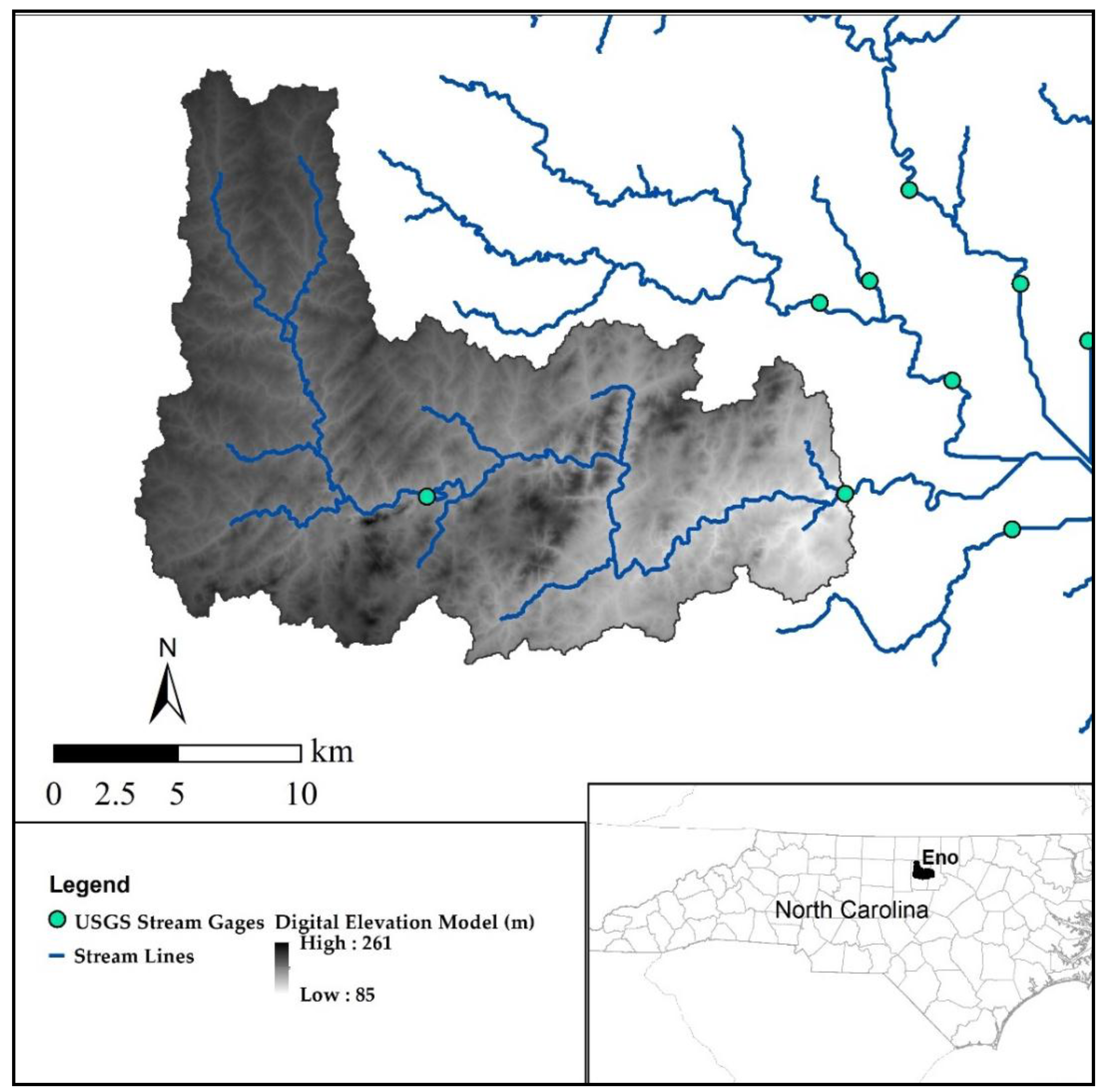
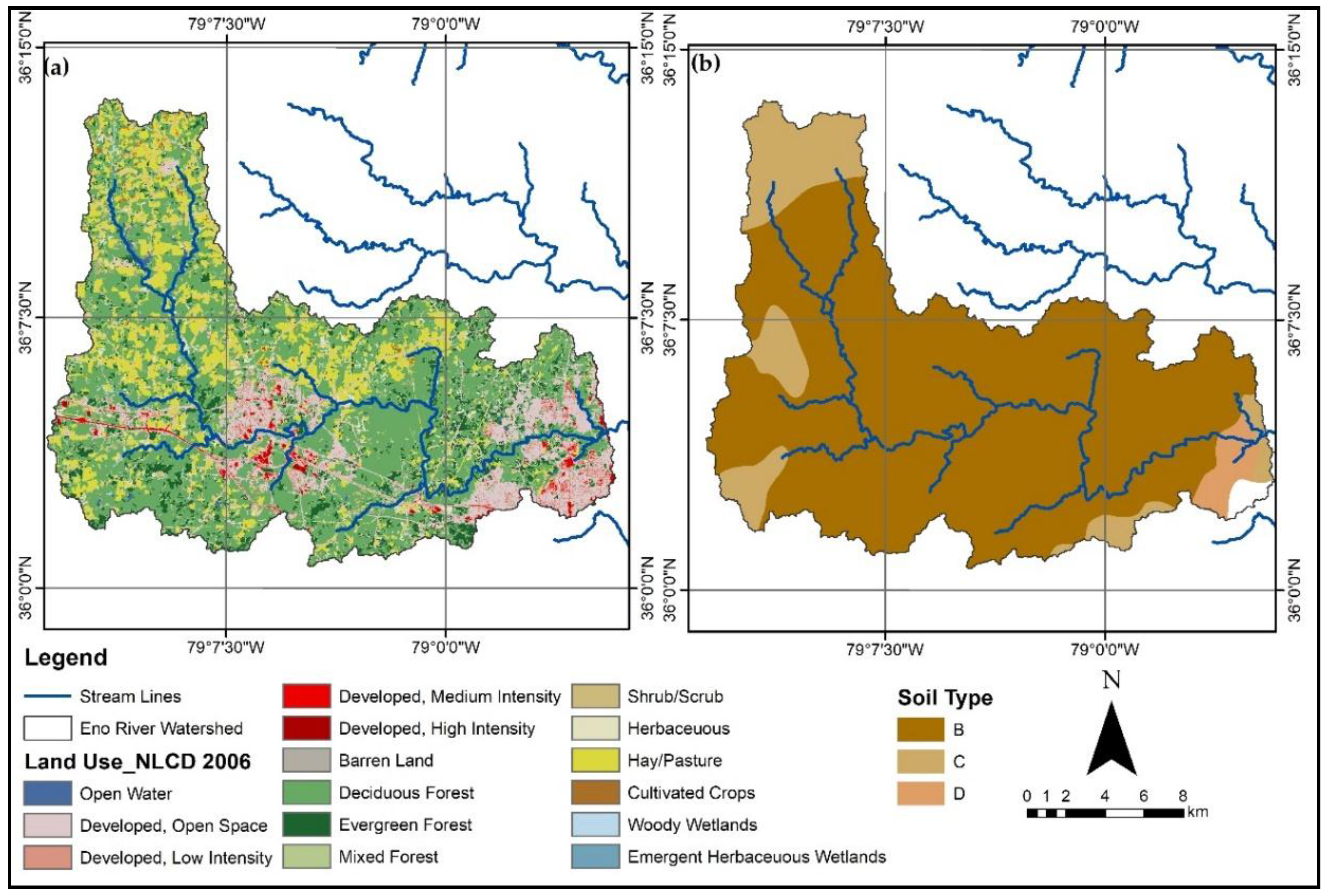
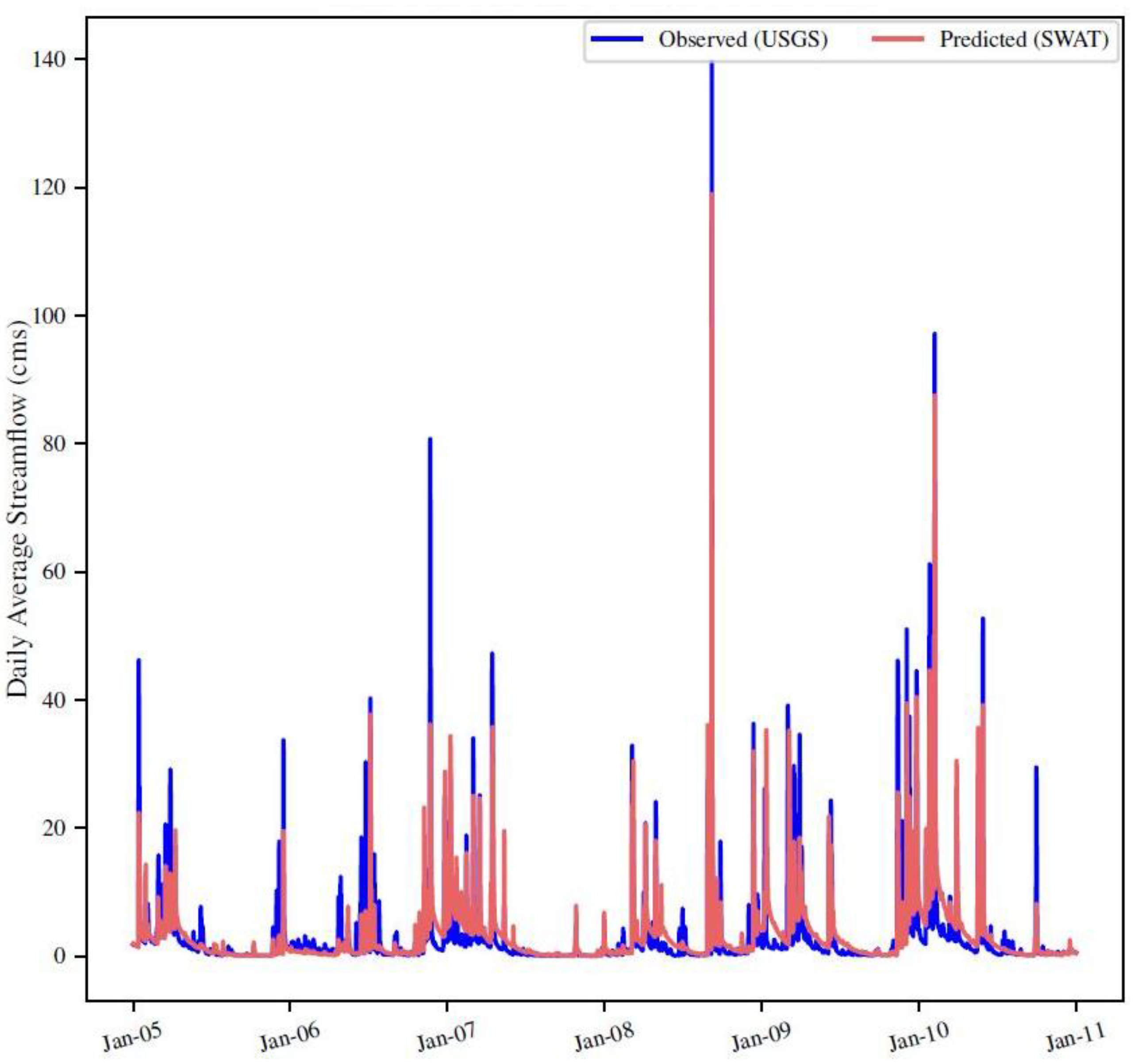
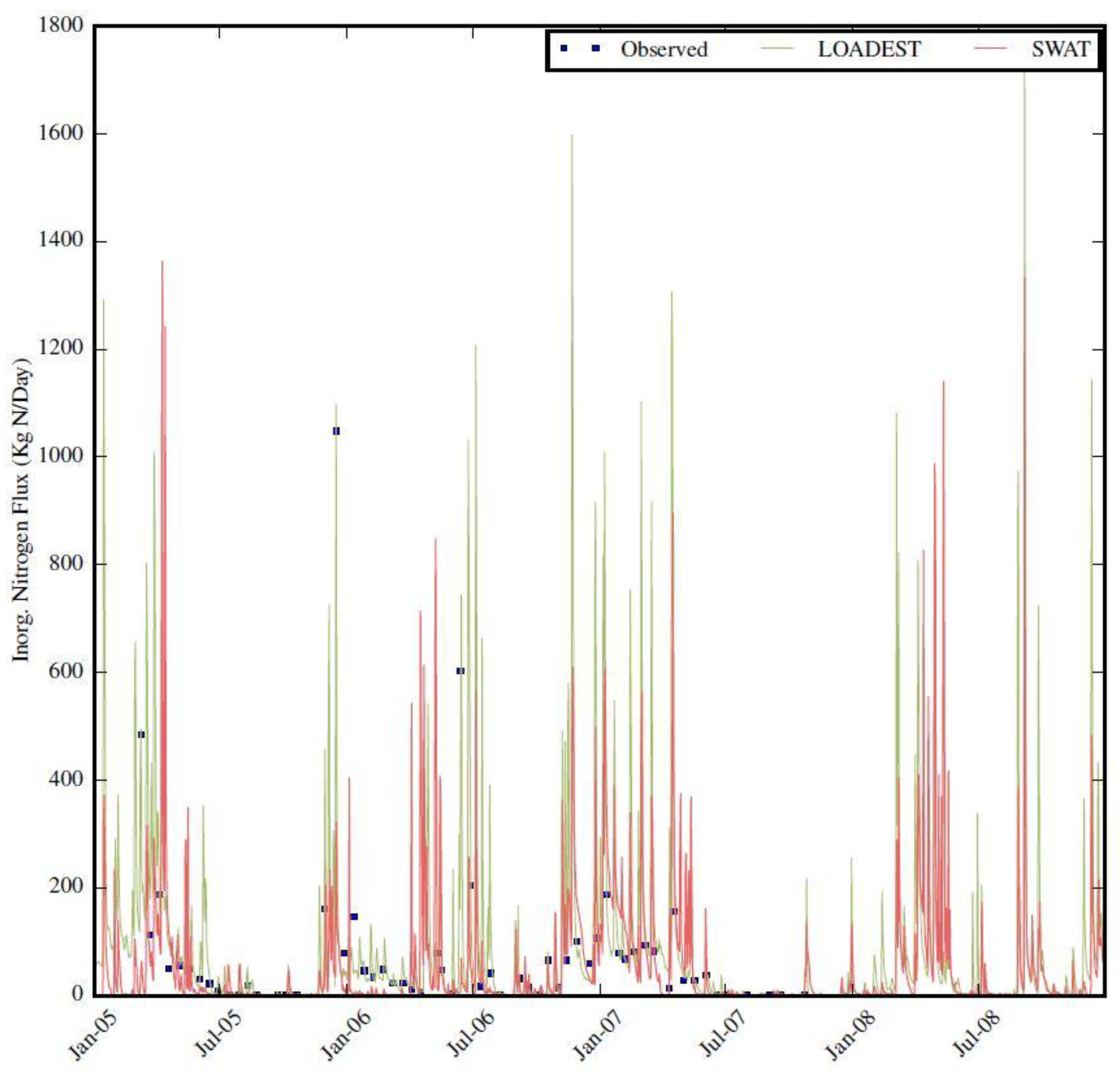
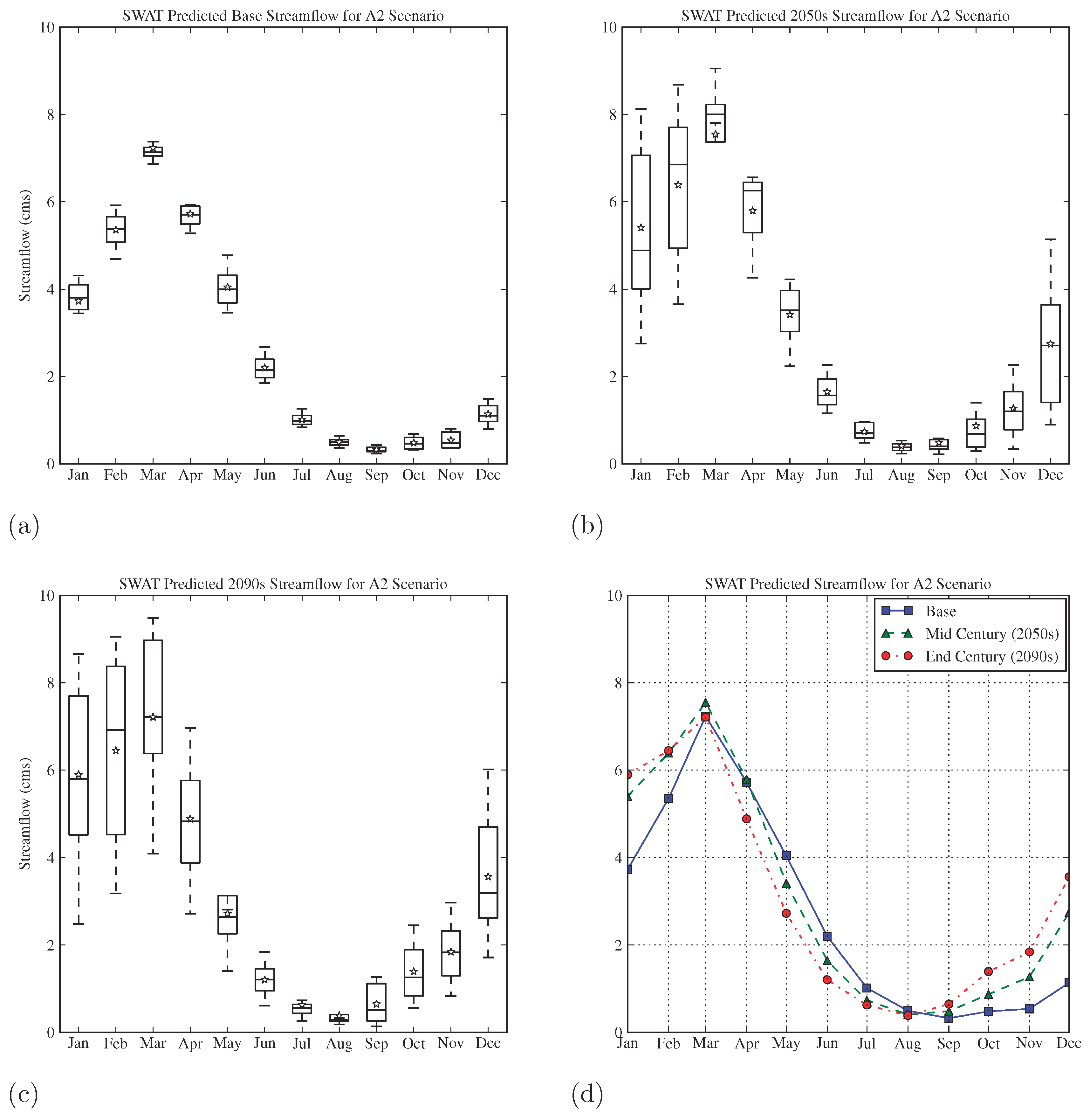
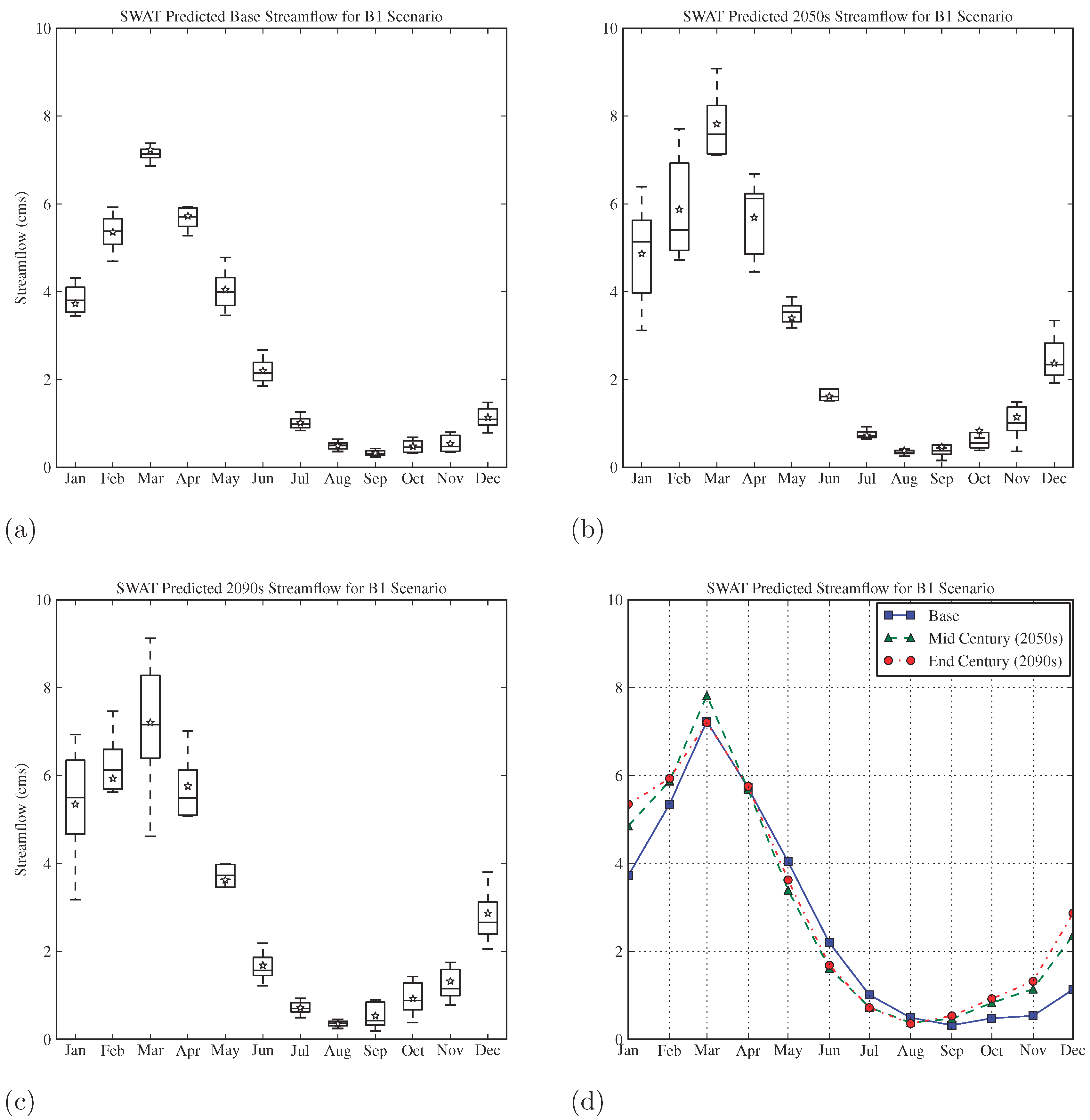

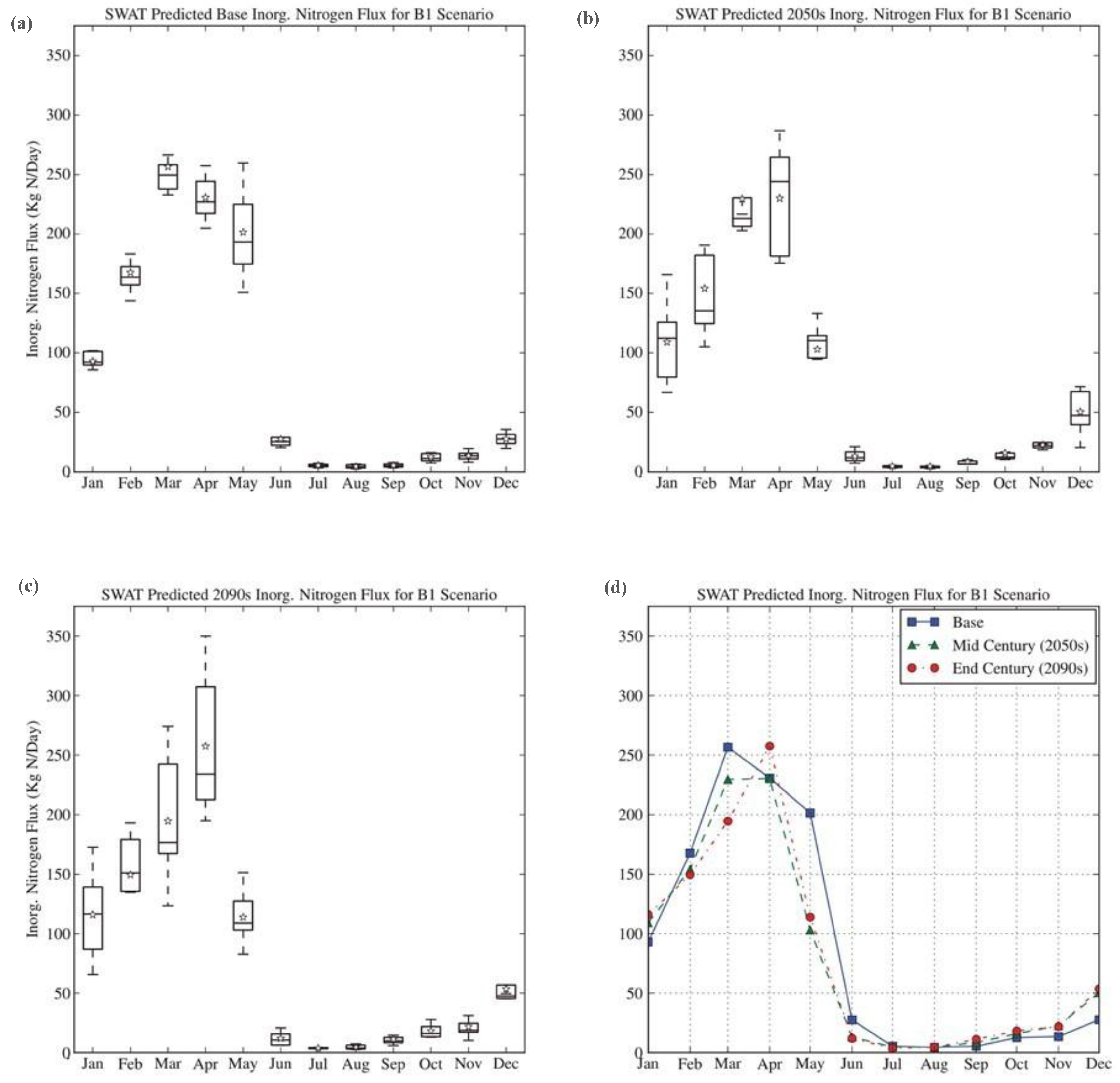
| Climate Models | Institutions, Sponsoring Agency, Country | References |
|---|---|---|
| CGCM3.1 (T47) | Canadian Centre for Climate Modeling & Analysis | [40] |
| CNRM-CM3 | Météo-France/Centre National de Recherches Météorologiques, France | [41] |
| GFDL-CM2.1 | US Dept. of Commerce/NOAA/Geophysical Fluid Dynamics Laboratory, USA | [42] |
| IPSL-CM4 | Institut Pierre Simon Laplace, France | [43] |
| MIROC3.2 (medres) | Center for Climate System Research (The University of Tokyo), National Institute for Environmental Studies, Frontier Research Center for Global Change (JAMSTEC), Japan | [44] |
| ECHO-G | Meteorological Institute of the University of Bonn, Meteorological Research Institute of KMA | [45] |
| ECHAM5/MPI-OM | Max Planck Institute for Meteorology, Germany | [46] |
| MRI-CGCM2.3.2 | Meteorological Research Institute, Japan | [47] |
| Time Period a | Scenario | CGCM 3.1 | CNRM-CM3 | GFDL-CM2.1 | IPSL-CM4 | MIROC 3.2 | ECHO-G | ECHAM5/MPI-OM | MRI-CGCM 2.3.2 |
|---|---|---|---|---|---|---|---|---|---|
| Change in Maximum Daily Temperature (°C) | |||||||||
| Mid | A2 | 2.2 | 2.0 | 2.6 | 2.6 | 3.0 | 2.6 | 1.8 | 1.7 |
| B1 | 1.5 | 1.6 | 1.6 | 2.2 | 2.4 | 1.8 | 1.8 | 1.5 | |
| End | A2 | 3.9 | 4.4 | 4.7 | 4.7 | 5.6 | 4.1 | 4.0 | 3.3 |
| B1 | 2.0 | 2.2 | 2.0 | 2.9 | 3.0 | 2.7 | 2.7 | 1.9 | |
| Change in Minimum Daily Temperature (°C) | |||||||||
| Mid | A2 | 2.4 | 2.1 | 2.6 | 2.7 | 2.7 | 2.6 | 1.9 | 1.7 |
| B1 | 1.7 | 1.5 | 1.7 | 2.2 | 2.1 | 1.8 | 1.7 | 1.4 | |
| End | A2 | 4.4 | 4.3 | 4.8 | 5.2 | 5.2 | 4.5 | 4.4 | 3.4 |
| B1 | 2.2 | 2.0 | 2.1 | 3.0 | 2.8 | 2.7 | 2.9 | 1.9 | |
| Change in Daily Precipitation (%) | |||||||||
| Mid | A2 | 5.9 | 12.3 | 12.4 | −12.2 | −14.7 | −1.9 | 12.5 | 2.6 |
| B1 | 1.0 | 1.4 | 7.9 | −4.7 | −6.7 | 4.5 | 5.7 | 1.9 | |
| End | A2 | 11.7 | 1.2 | 3.8 | −13.6 | −21.3 | 4.5 | 13.3 | 6.5 |
| B1 | 3.2 | 10.1 | 10.2 | −10.0 | −0.9 | −4.1 | 8.1 | −3.7 | |
| Time Period a | Scenario | CGCM 3.1 | CNRM-CM3 | GFDL-CM2.1 | IPSL-CM4 | MIROC 3.2 | ECHO-G | ECHAM5/MPI-OM | MRI-CGCM 2.3.2 |
|---|---|---|---|---|---|---|---|---|---|
| Change in Streamflow (%) | |||||||||
| Mid | A2 | 21.8 | 34.8 | 59.6 | −29.9 | −25.2 | −5.5 | 45.2 | 19.0 |
| B1 | −2.5 | 2.2 | 35.3 | −4.2 | −5.3 | 9.3 | 31.2 | 11.2 | |
| End | A2 | 37.2 | 13.4 | 39.3 | −35.4 | −38.0 | 12.1 | 58.0 | 29.5 |
| B1 | 10.2 | 35.5 | 43.3 | −21.8 | 14.4 | −6.6 | 33.5 | 0.1 | |
| Change in Inorganic Nitrogen Loading (%) | |||||||||
| Mid | A2 | 12.0 | 28.6 | 34.6 | −44.9 | −40.5 | −36.2 | 33.5 | 0.7 |
| B1 | −17.0 | −11.5 | 11.4 | −23.3 | −12.1 | −25.5 | 23.0 | −14.3 | |
| End | A2 | 15.9 | −9.9 | 9.8 | −53.4 | −51.1 | −27.1 | 25.2 | −1.9 |
| B1 | −11.1 | 4.4 | 24.4 | −20.1 | 2.4 | −32.5 | 3.1 | −26.6 | |
| Climate Scenario | Period | Winter | Spring | Summer | Fall |
|---|---|---|---|---|---|
| Percent change in streamflow | |||||
| A2 | Mid Century | 42.21 | −1.43 | −24.85 | 95.83 |
| A2 | End Century | 55.60 | −12.79 | −40.32 | 189.43 |
| B1 | Mid Century | 28.28 | −0.53 | −26.35 | 82.58 |
| B1 | End Century | 38.53 | −2.39 | −25.39 | 107.70 |
| Percent change in inorganic Nitrogen | |||||
| A2 | Mid Century | 20.52 | −14.71 | −31.95 | 59.38 |
| A2 | End Century | 21.38 | −29.60 | −48.74 | 107.81 |
| B1 | Mid Century | 8.84 | −18.32 | −39.60 | 49.57 |
| B1 | End Century | 10.66 | −17.8 | −45.79 | 63.16 |
© 2018 by the authors. Licensee MDPI, Basel, Switzerland. This article is an open access article distributed under the terms and conditions of the Creative Commons Attribution (CC BY) license (http://creativecommons.org/licenses/by/4.0/).
Share and Cite
Alam, M.J.; Ercan, M.B.; Zahura, F.T.; Goodall, J.L. Using Geospatial Analysis and Hydrologic Modeling to Estimate Climate Change Impacts on Nitrogen Export: Case Study for a Forest and Pasture Dominated Watershed in North Carolina. ISPRS Int. J. Geo-Inf. 2018, 7, 280. https://doi.org/10.3390/ijgi7070280
Alam MJ, Ercan MB, Zahura FT, Goodall JL. Using Geospatial Analysis and Hydrologic Modeling to Estimate Climate Change Impacts on Nitrogen Export: Case Study for a Forest and Pasture Dominated Watershed in North Carolina. ISPRS International Journal of Geo-Information. 2018; 7(7):280. https://doi.org/10.3390/ijgi7070280
Chicago/Turabian StyleAlam, Md Jahangir, Mehmet B. Ercan, Faria Tuz Zahura, and Jonathan L. Goodall. 2018. "Using Geospatial Analysis and Hydrologic Modeling to Estimate Climate Change Impacts on Nitrogen Export: Case Study for a Forest and Pasture Dominated Watershed in North Carolina" ISPRS International Journal of Geo-Information 7, no. 7: 280. https://doi.org/10.3390/ijgi7070280
APA StyleAlam, M. J., Ercan, M. B., Zahura, F. T., & Goodall, J. L. (2018). Using Geospatial Analysis and Hydrologic Modeling to Estimate Climate Change Impacts on Nitrogen Export: Case Study for a Forest and Pasture Dominated Watershed in North Carolina. ISPRS International Journal of Geo-Information, 7(7), 280. https://doi.org/10.3390/ijgi7070280




